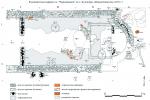Summary (English)
ARCHAEOLOGICAL EXPLORATIONS NEAR THE VILLAGE OF BUZOVGRAD (Deyan Rabovyanov – rabovyanov@gmail.com, Kalin Chakarov) The fortress and the church situated nearby were built on a hill. The fortress was constructed during the 6th century AD and covered an area of 1.3 ha. The fortification walls were built in opus incertum from roughly-cut stones bonded with mortar. Two towers and two parallel fortification walls on the southern side of the fortress were documented. The fortress was burned during the 6th century AD and subsequently it was reoccupied during the 11th – 14th centuries. The church was built during the 6th century AD, judging from the sherds that were found. It was c. 20 m long and the apse was 5.90 m wide. The walls were 70 cm wide, built of stones bonded with mortar. The church was single-naved, single-apsed, with a timber roof covered with tiles. Its outer walls were covered with yellow-pink plaster and there were windows, judging from the glass fragments. Three entrances were discovered. The floor was covered with pink plaster. Fragments from frescoes were found. A crypt that accommodated a reliquary, 1.05 m by 0.70 m in size, was dug into the bedrock beneath the altar. A fragment from marble plate with Greek inscription was found in front of the apse. The church was repaired in rubble masonry and a narthex was constructed in its western part. Probably at the end of the 6th – beginning of the 7th century AD, the church was burned during the Slavic invasions. Two pieces from a metal sheet of reliquary and iron plates from plated mail were found. A fragmentary Early Slavic pot was discovered in the layer with debris. Sherds of the 7th – 9th centuries AD associated with the Slavs were also found.
- Deyan Rabovyanov - Veliko Tarnovo Branch of the Archaeological Institute and Museum
- Kalin Chakarov - Regional Museum of History – Veliko Tarnovo
Director
Team
Research Body
- Veliko Tarnovo Branch of the Archaeological Institute and Museum






![Download [PDF]](/excavation/skins/fasti/images/results/download_sml.png)
